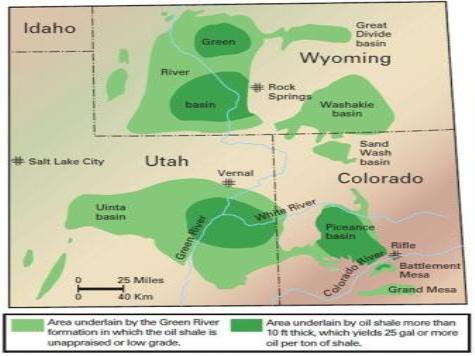
The President has recently made a habit of claiming that oil self-sufficiency is impossible because the US has just 2% of the world’s oil reserves. However, congressional testimony given Thursday May 10th reinforces that America is exceedingly rich in natural resources, especially a type of oil reserves known as oil shale.
However, the testimony also pointed out that the future development of these resources, 72 percent of which is controlled by the Bureau of Land Management, is largely up to the federal government. The present administration doesn’t seem very eager to get at those (or other) natural resources.
The GAO testimony last week highlighted just how significant the oil shale reserves in the western United States are:
Being able to tap the vast amounts of oil locked within U.S. oil shale formations could go a long way toward satisfying the nation’s future oil demands. The Green River Formation–an assemblage of over 1,000 feet of sedimentary rocks that lie beneath parts of Colorado, Utah, and Wyoming–contains the world’s largest deposits of oil shale. USGS estimates that the Green River Formation contains about 3 trillion barrels of oil, and about half of this may be recoverable, depending on available technology and economic conditions. The Rand Corporation, a nonprofit research organization, estimates that 30 to 60 percent of the oil shale in the Green River Formation can be recovered. At the midpoint of this estimate, almost half of the 3 trillion barrels of oil would be recoverable. This is an amount about equal to the entire world’s proven oil reserves.
The report makes clear what this level of resource development could mean for our economy:
Development of oil shale resources could lead to the creation of jobs, increases in wealth, and increases in tax and royalty payments to federal and state governments for oil produced on their lands. The extent of these benefits, however, is unknown at this time because the ultimate size of the industry is uncertain.
However, the government is also concerned about the environmental impacts, specifically that development could “have significant impacts on the quality and quantity of surface and groundwater resources.” The current GAO testimony largely recapitulates a report issued in 2010 calling for more study of the water resources in the area. For its part, the BLM issued a draft environmental impact statement in February that also focuses on further study as a first step.
This approach is in keeping with the administration other moves largely in opposition to the development of North American oil and gas reserves. The administration refused to permit the Keystone XL pipeline, citing environmental concerns, which would have delivered oil from Canadian tar sands to the gulf coast. At the end of March the administration also used the pretext of further environmental study to delay the possibility of offshore Atlantic oil drilling leases for a minimum of five years. Obama’s EPA is currently investigating hydraulic fracturing (“fracking”), which has recently led to a boom in natural gas production in the US. Simultaneously, the Obama EPA has released new coal plant regulations which make the cost of coal prohibitive and have already led to the closing of numerous coal plants.
In a bit of spin worthy of George Orwell, Obama calls this his “all of the above” energy strategy.

COMMENTS
Please let us know if you're having issues with commenting.